MSI Z77IA-E53
There are more and more Mini-ITX mainboards
allow building high-performance PC configurations. This market is becoming
highly competitive and manufacturers have to try hard and put out original and
attractive solutions. Products from MSI based on the Z77 features a free
combined mini-PCIe/mSATA slot which can accommodate SSDs as well as expansion
cards. This slot is easier to user than the one on the ASRock Z77E-ITX. It is
located on the face side of the PCB and has fasteners for half-length as well
as full-size cards.

ASRock
Z77E-ITX
The addition of mini-PCI/mSATA slot does
not affect the rest of the mainboard’s capabilities much. Like most of its
rivals, it is equipped with both WiFi and Bluetooth controllers, but they are
connected via USB and, designed in a compact form-factor, gathered on the back
panel. This deployment doesn’t affect the speed of wireless data transfer much.
A Bluetooth module with USB interface is actually a typical solution. For Wifi
module, it is really original. Based on an Atheros AR9271 chipset, it supports
802.11n/g/b and works in the 2.4GHz frequency band. The implementation we see
here implies only one antenna, so the bandwidth is limited to 150 MNPS. If you
do not like the default wireless module of MSI Z77IA-E53, you can neatly remove
them and replace them with a mini-PCIe card.

Three
combined expansion slots and the wireless USB adapters
Unfortunately, the three combined expansion
slots and the wireless USB adapters are all the plus points that Z77IA-E53 MSI
can provide. The rest of its capabilities come from its chipset. It has no
additional chips for more USB and SATA ports. There is no doubt that it only
carries one onboard header for two USB 2.0 ports and one header for two USB 3.0
ports. The number of SATA connectors is limited to four: two 3 Gb/s ports and
two 6 Gbit/s ones.
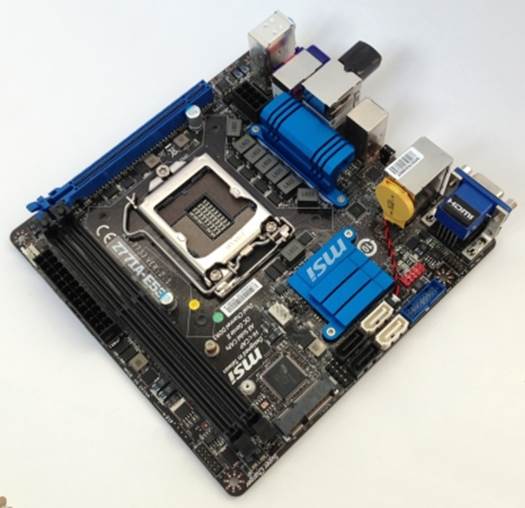
The
Z77IA-E53 MSI does not contain too many components
Although Z77IA-E53 MSI does not contain too
many components, its layout is rather inconvenient. Connectors that are
supposed to be attached to the computer case’s I/O ports are located at the
farther end of the PCB. However, the ATX power connector is located quite
good. The LGA1155 socket is too close to the PCI Express x16 slot, preventing
you from installing the advanced CPU cooler, especially if the graphics card
has a heatsink or a stiffening plate at the back. Therefore, the mainboard is
only compatible with the cooling tower design for 80mm or 92mm fan and with
water-cooling solutions. Air cooler can only be good if you use the integrated
graphics card.
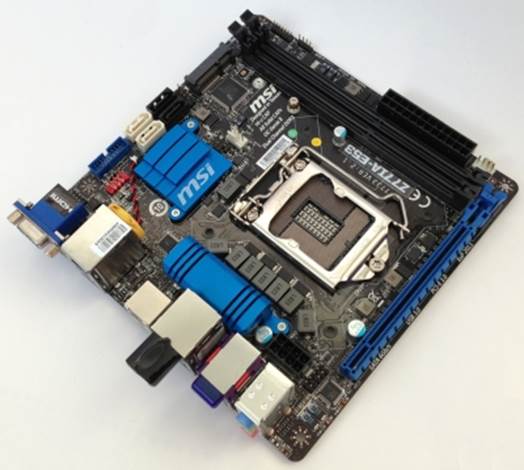
The
ATX power connector is located pretty good
The MSI Z77IA-E53 is not that
interesting,too. Unlike the rest Mini-ITX mainboards based on the Z77, it just
offers two video connectors: D-Sub and HDMI. It means you cannot connect
three monitors to the integrated graphics core and even may have problems
connecting both a monitor and a TV-set at the same time. Then, there are only
three analog audio outputs on the back panel. Although the mainboard uses an
eight-channel Realtek ALC892 codec, you cannot output more than six audio
channels. The Asus P8Z77-I DELUXE solve this problem by providing a SPDIF
output and the Z77IA-E53 MSI also has an optical SPDIF, but it does not support
DTS Connect.

The
back panel also provides four USB 2.0 ports, two USB 3.0 ports and one eSATA 3
Gbit/s
The back panel also provides four USB 2.0
ports, two USB 3.0 ports and one eSATA 3 Gbit/s - all supported by the
chipset. The Gigabit Ethernet connector you can see nearby is based on a
Realtek 8111E controller. A PS/2 jack for mouse and keyboard and a Clear CMOS
button, which became typical features of a modern mainboard for a few reasons,
also appeared. Note that WiFi module of the mainboard is an uncommon MC
antenna connector.
The MSI Z77IA-E53 features a six-phase CPU
voltage regulator which is made of integrated DrMOS components, solid-state
capacitors and ferrite-core chokes. A simple heatsink is fixed on the hottest
parts with screws. The voltage regulator does not get too hot when operating,
so this cooling solution is quite effective. A similar heatsink is mounted on
the chipset and copes with its job just as well. There are only two fan
connectors on the mainboard, one of which is for a CPU fan. Both are of the
4-pin variety and do not support speed regulation for 3-pin fans.
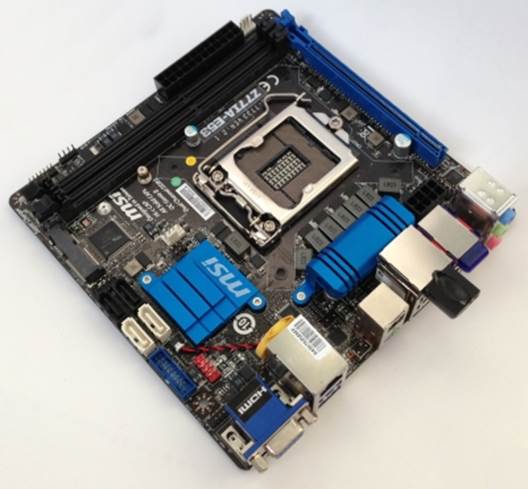
The
MSI Z77IA-E53 features a six-phase CPU voltage regulator
Included with the mainboard is a Wi-Fi
antenna, two SATA cables, and an I / O Shield. No extras here.
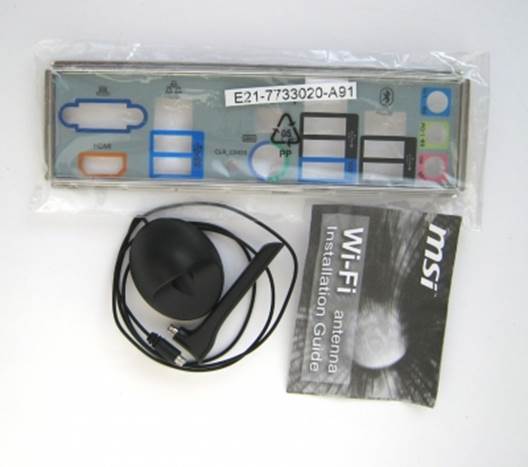
Accessories
Mainboard manufacturers tend to transfer
their BIOS solutions to compact product with certain simplifications. The MSI
Z77IA-E53 is an exception because its BIOS offers the same options in MSI’s
standard graphical interface as you get with MSI’s full-size mainboards. The
interface is not user-friendly because some settings are distributed among its
sections in an illogical away, but it does not limit your setup opportunities.
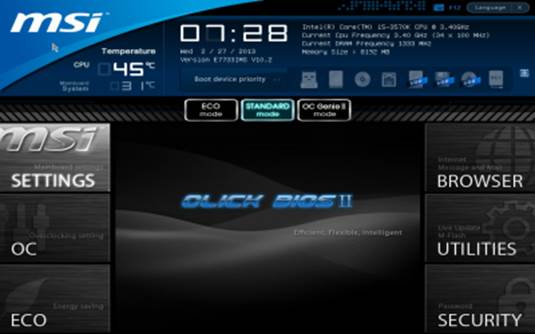
The
interface is not user-friendly
Most parameters related to CPU and memory
are grouped in a dedicated section. You can adjust the multipliers for CPU and
DDR3 SDRAM frequencies and set up voltages in a rather wide range. The
mainboard can counteract CPU voltage drop at high loads. However, you can not
set the CPU voltage by using an offset value, which is a typical drawback of
any MSI products. This means that by changing the voltage you disable
power-saving technologies, so overclocking and downclocking are far from
attractive.

The
mainboard can counteract CPU voltage drop at high loads
There is a seperate section with memory
timings. You can change anything and use the XMP profiles. You can change them
individually for each DDR3 SDRAM slot.

There
is a seperate section with memory timings.
CPU technologies are set up in a seperate
section, too, except Turbo Boost and Enhanced Intel SpeedStep which are
activated on the main page.
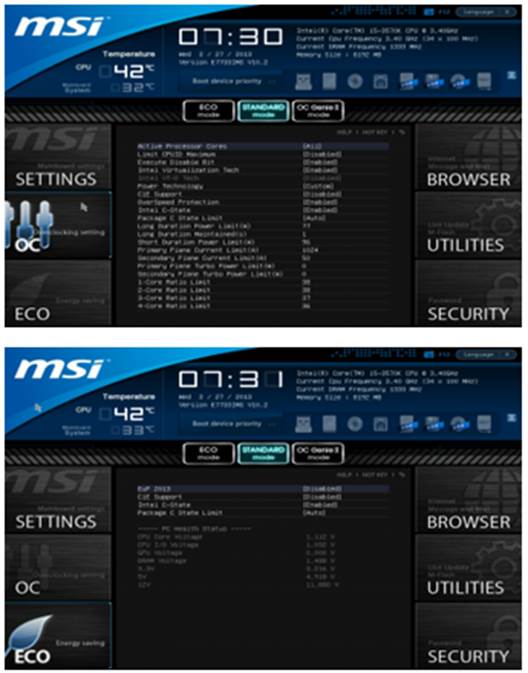
CPU
technologies are set up in a seperate section
MSI BIOS provides a set of useful utilities
so you can update software, manage configuration settings (also using an
external drive) and have thorough information about your CPU and memory
modules.
The MSI Z77IA-E53 does not really handy for
CPU overclocking as it looks. Its inability to set the CPU voltage by an
offset value is a major drawback, especially for a Mini-ITX product. Changing
the CPU multiplier manually makes it fixed at the specified level. Therefore,
when you overclock your Z77IA-E53, the CPU will always operate at increased
voltages and frequencies even when idle, although most other mainboards can
reduce this parameter at low load. The increased power consumption and heat
dissipation is not acceptable for a Mini-ITX mainboard.
Therefore, the MSI Z77IA-E53 is not good
for building a compact overclocking platform but we have nothing to complain
about its operation in the default setting. On the other hand, if you do not
want to overclock, you may prefer a mainboard with Intel’s H77 chipset that
will provide the same functionality, except for CPU overclocking options.
|
MSI
Z77IA-E53’s specs
·
CPU (Max Support): i7
·
FSB / Hyper Transport Bus: 100MHz
·
Chipset: Intel® Z77
·
DDR3 Memory:
1066/1333/1600/1866*/2000*/2133*(OC), 200*/ 2400*/ 2600*/2667*/ 2800* (OC,
22nm CPU required)
·
Memory Channel: Dual
·
DIMM Slots: 2
·
Max Memory: (GB)16
·
PCI-Ex16: 1
·
PCI-E Gen: Gen3 (16)
·
SATAIII: 2
·
SATAII: 2
·
RAID: 0/1/5/10
·
LAN: 10/100/1000*1
·
USB 3.0 ports:(Rear): 2
·
USB 2.0 ports: (Rear): 4
·
Sound jacks: (Rear): 3
·
eSATA: 1
·
VGA: 1
·
HDMI: 1
·
VGA Max Share Memory: (MB)1760
·
DirectX: 11
·
Form Factor: Mini ITX
|